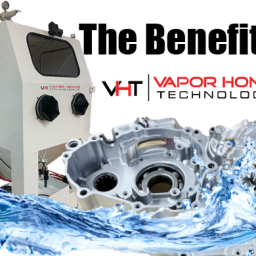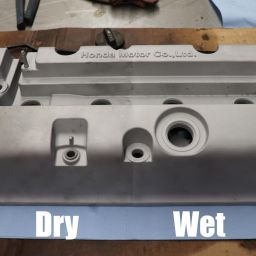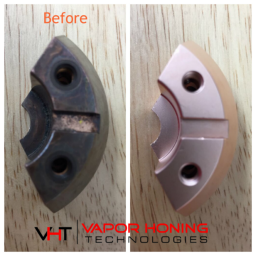What is Vapor Blasting (Wet Blasting) and How Does It Work?
Way back in the 1800s, an American called Benjamin Tilghman revolutionized industrial and domestic cleaning with the invention of the sandblaster. This new piece of equipment allowed people to clean more efficiently and thoroughly than ever before.
However, since then methods of ‘blast’ cleaning have come on in leaps and bounds. During the 1950s, wet or vapor blasting was invented in the United Kingdom as an alternative to sandblasting. It then swept across Europe and arrived in the United States in the 1960s.
If you’re interested in using vapor blasting at home or at work, you need to know what you’re doing first. So what is vapor blasting and how does it work?
Read on to find out more!
What Is Vapor Blasting?
You may already be familiar with the concept of vapor blasting, even if you don’t know it by this name.
This involves blasting water and compressed air against a surface in order to clean it. It is also known as wet blasting, vapor honing, and dustless blasting.
You can use vapor blasting to remove almost anything from surfaces such as stone, metal, or concrete. For example, you could use it to clean a car or to remove dirt from a garden patio.
Whatever you need it for, vapor blasting will get the job done quickly and thoroughly. Unlike sandblasting, vapor blasting is also less likely to produce excess debris or damage the surface below. This is because the water used weighs down any debris that comes away while you clean.
How Does Wet Blasting Work?
There are various different ways to use wet blasting to clean surfaces or objects. All these work on a similar basis, combining three key elements:
- Water
- Compressed air
- Abrasive organic materials, such as aluminum oxide or bauxite beads
Abrasives are useful if you want to create a profile on the surface you are cleaning. It is easier to coat surfaces that are profiled, so this is ideal if you are planning to clean and repaint a car, for example.
Wet blasting works by targeting a blast of water and abrasive particles on the object or surface that you are cleaning. When these hit the surface, the fine abrasive particles break the surface of whatever you are trying to remove. For example, they will chip through paint or dirt easily.
Thanks to the water, whatever you have chipped away with the initial blast does not come flying off as dust. Instead, it is weighed down, making it easy to wash or wipe away.
Different Types of Vapor Blasting Methods
There are various different styles of vapor blasting machines that you can use. These follow the same principles of combining water with abrasive particles. However, the way they do this varies depending on the equipment you are using.
Some vapor blast machines are better suited to specific jobs than others. For example, some require a lot of energy to run or are less flexible. Finding the right one for you depends a lot of what you want to use it for.
WIN and Halo Nozzle Adapters
If you already have a sandblaster, you can adapt it into a wet blaster using a WIN or Halo nozzle. These incorporate water into the abrasive blast to reduce dust on impact.
WIN, or water injection nozzles, work by dampening the abrasive material as it is leaving the blaster. Halo or water ring nozzles surround your existing nozzle and spray out a jet of water around the abrasive blast. This contains the dust produced on impact with the surface you are cleaning.
These are cheap adaptations however they won’t completely eliminate the dust produced and they use up a lot of water.
Cabinet and Blast Rooms
If you have a specific object that you want to clean then you can use a wet blasting cabinet or a blast room. This involves securing an object inside a sealed enclosure before blasting it with a mixture of water and abrasive particles.
This is an extremely efficient way to clean objects and it lets you recycle the media used. The main limitation of a wet blasting cabinet is its size. You can only clean objects that will fit inside the cabinet’s enclosure so can’t use it to clean large surfaces.
Modified Sandblasters
Using a modified sandblaster is a little more complicated than attaching a new nozzle on a sandblaster you already own. However, it will produce much more impressive results.
These vapor blasting machines mix the abrasive you are using with water before it enters the compressed air flow. This is stored in the machine under air pressure. The venturi effect then draws this mixture out into the flow of compressed air before releasing it in a blast.
Combining the abrasive with the water inside the machine makes for much more effective dust suppression. However, it does use a lot of water and abrasive mix and the venturi effect is hard to control. This means that the flow may vary a little while you use it.
Vapor Abrasive Blasters
Vapor abrasive blasters work in a similar way to modified sandblasters. They also combine the water and abrasive particles. However, this mixture is then stored under water pressure and is injected into the air flow.
Vapor abrasive blasters allow more flexibility and precision when cleaning compared to cabinets. On top of this, they offer even more dust suppression and control than modified sandblasters. They are also extremely efficient and don’t waste excessive amounts of the water-abrasive mixture.
Benefits of Vapor Blasting
There are lots of benefits to using a blasting machine when cleaning but why is vapor blasting so great?
As we’ve already mentioned, it is an extremely quick way of cleaning surfaces thoroughly. Vapor blasting allows you to target specific areas for cleaning and helps you get in all the nooks and crannies of whatever you’re cleaning. But this isn’t the only benefit of using a vapor blaster.
Compared to sandblasters, vapor blasters produce a lot less dust and debris when you clean. This doesn’t just make your job easier, it also protects your health.
Exposure to dust and debris when using a sandblaster can lead to serious health complications, such as silicosis. This can have an impact on your long-term respiratory health and this is why the use of sandblasters is now banned in Europe and the United Kingdom.
Using a vapor blaster won’t prevent dust and debris. However, the water will catch this and weigh it down so you are less likely to inhale toxic materials while cleaning. This means you don’t need to wear as much protective clothing while vapor blasting.
It also means that people can work around you safely. So if you’re working in construction, using a vapor blaster will help you complete your whole project more efficiently and safely.
As well as protecting you and the people working around you, vapor blast is also more environmentally friendly. Using biodegradable abrasives means that you don’t have to use toxic chemicals or pollutants while cleaning.
One of the biggest benefits of using vapor or liquid blasting, however, is its versatility. To understand this properly, let’s take a look at a few of the applications and industries where vapor blasting is used.
Vapor Honing Soft Metals and Delicate Surfaces
Cleaning metals and delicate surfaces can be a challenge. This is because you risk damaging the surface below when heating, scrubbing, or scratching off debris. Thankfully, vapor honing provides a way of cleaning without damaging metal and other delicate surfaces.
This is because the water used in vapor blasting creates a cushion between the abrasive particles and the surface. This means that the impact of the abrasive is not direct and is, therefore, gentler on the surface you are cleaning.
When cleaning certain types of reactive metals, you can provide even more protection by using a rust-inhibiting solution. You should apply this before cleaning and when washing down the surface afterward.
Historic Restoration Work
Historic buildings and artifacts are invaluable pieces that provide a snapshot into a particular period of the past. Because of this, they require special care, and cleaning them with the wrong equipment can be catastrophic.
Sandblasting historic buildings can do enormous damage, especially to delicate brick or stonework. On top of this, using the wrong chemicals on these surfaces can cause irreversible damage and erosion.
Fortunately, water is much gentler on these delicate surfaces. This means that you can use vapor blasting to restore them to their former glory without affecting their historic integrity.
Industrial Cleaning
Certain industries produce a lot of mess.
For example, facilities that deal with oil or natural gases can quickly become very messy and dangerous to work in. Wherever grease builds up, this creates a serious health and safety issue.
On top of this, cleaning up oil, grease and natural gases needs to be done very carefully. Not doing this right could result in static build-up, dust plumes, and, eventually, a fire or explosion.
This is where vapor blasting provides a safe solution. By keeping dust and debris to a minimum, it is the safest way to clean away potentially dangerous materials.
Cleaning Car Parts
Another industry that encounters a lot of grease and grime is the automotive industry. Whether you’re working in a car factory or are just giving your engine the once over, wet blasting is a great way to efficiently clean a car’s engine.
Not only does it cut through engine grease easily, but the high compression blast is also ideal for getting into tiny holes and grooves. This means that you can reach all of those fiddly, hard-to-reach places quickly.
When cleaning your car engine, dust is the last thing you want to worry about. Even a tiny amount of dust or debris in your engine could clog up vital mechanisms.
This means that using a sandblaster to clean it is an absolute no-go. Vapor blasting is the perfect tool for the job!
Working With Airborne Dust Regulations
We’ve already touched upon some of the health risks associated with using a sandblaster to clean objects or surfaces.
Because of these, legal airborne dust regulations are in place in a lot of industries. These are in there to protect anyone using a sandblaster and the people living or working around them.
These restrictions limit the length of time that you can use a sandblaster in certain environments. For example, you can use a sandblaster for shorter periods of time inside compared to outdoors. This is because dust from the sandblaster will build up much quicker indoors.
There are also restrictions on the type of protective equipment you must wear when using a sandblaster and how long you can use one in an urban environment.
Fortunately, there are very few containment requirements for using a vapor blasting machine. This is because of risks of using vapor blasting are significantly lower.
This means that it is considerably quicker to use a vapor blasting machine compared to a sandblaster. Because of this, a lot of industries, such as construction, favor vapor blasting over sandblasting.
Want to Know More?
As you can see, when it comes to cleaning surfaces safely, efficiently, and without doing any damage, vapor blasting is the obvious choice. Whether you’re looking to clean the front of your house or give your car a new lease of life, a vapor blasting machine can help.
Ready to get kitted out? Then check out our vapor honing equipment to find everything you will need!








